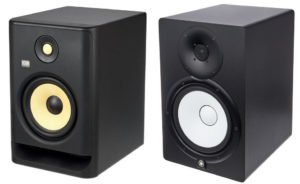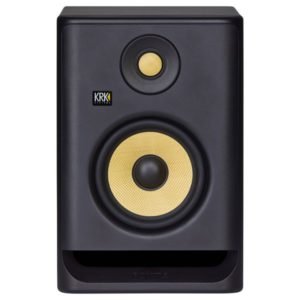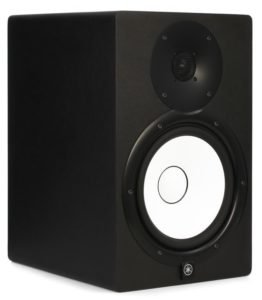They are by far the most recognisable home studio monitor ranges – the KRK Rokit and Yamaha HS monitor series are renowned for being excellent, budget-friendly speakers for music production and casual listening. But which brand is a better option for your requirements? This article breaks down the specs and differences between these monitors so you can be sure of your decision.
TLDR: KRK Rokits generally give a slight boost to the low-end, making them well suited for doubling up as monitors for music production and DJing; Yamaha HS generally give a more accurate, flatter sound making them ideal for mixing and mastering music. That being said, they’re both excellent options.
Looking for studio monitors to suit your production needs? Check out our guides such as the best studio monitors for bass or EDM.
KRK Rokits Overview
KRK Rokit Specs
| ||
| ||
|
KRK Rokit Breakdown
The Rokit series is arguably the most instantly recognisable speaker globally; its slick black and yellow design is a fixture of home studios, bedrooms and living rooms everywhere. And their popularity isn’t just down to looks – KRK Rokits sound great and are extremely affordable.
The entire range has an impressive frequency range, up to 40KHz at the high end and down to 36Hz if you opt for the larger KRK Rokit 8 G4, with the smallest monitor, the Rokit 5 G4, going down to a very respectable 43Hz. Many other home studio monitors require an additional subwoofer to really get an accurate, punchy bass, whereas the smallest Rokit performs brilliantly by itself. It’s worth noting that there’s a 10″ woofer and 3″ tweeter version Rokit (the KRK Rokit 10-3 G4), but this list considers near-field monitors suitable for home use only.
Although KRK Rokits are excellent sounding speakers, there’s a general consensus that they boost the low and mid frequencies slightly, i.e. they do not provide a truly accurate representation of the sound source. However, at their price point it’s near impossible to find a monitor with as flat a frequency response – otherwise you wouldn’t find them in both professional and home studios.
KRK Rokit Users
Rokits have been seen in studios used by artists spanning multiple genres:
- Skrillex
- KAYTRANADA
- Charlie Puth
- Mac Miller
- Four Tet
Yamaha HS Overview
Yamaha HS Specs
| ||
| ||
|
Yamaha HS Breakdown
The Yamaha HS series is a firm favourite of music producers and engineers. They’re renowned for their incredibly rich sound, yet affordability. And the white woofer is the classic, much sought after design that Yamaha has been synonymous with since the 70s.
The HS Series has a more than adequate high-end range of up to 30KHz, with the biggest model reaching down to 38Hz, and the smallest down to 54Hz. While Yamaha HS speakers have an exceptionally flat response across the frequency spectrum, it’s the low end in particular that is seriously impressive. Most home studio monitors struggle to replicate an accurate representation of sub bass and low frequencies, but the Yamahas output a deep, detailed and highly accurate low-end.
While they are still very much affordable speakers, the Yamaha HS series tends to retail slightly higher in price compared to other monitors on the market. This can make it attractive to opt for a cheaper option, but you simply won’t find a monitor that outputs such a flat frequency response in this price range.
Yamaha HS Users
An absolute staple of professional and home studios, Yamaha HS Series monitors are used by artists such as:
- A-Track
- Metro Boomin
- Odesza
- San Holo
- Joey Bada$$
KRK Rokits vs Yamaha HS
So looking at these iconic monitor ranges head to head, which should you go for?
If you’re looking for speakers with the most accurate possible response – perhaps your focus is on perfecting track mixing and mastering – the Yamaha HS series definitely outperforms the KRK Rokits. The Rokits exaggerate the low frequencies slightly, which could have an impact on your final track if you do not take this into consideration, whereas the HS series’ output is extremely honest to the original sound.
On the other hand, if you’re planning to use monitors for DJing as well as music production or general use, Rokits may be a better option where some slight emphasis on the lower frequencies is preferable for a more enjoyable listening experience. The Rokit G4 series also offers an accompanying app to help you tweak your setup which may be appealing to you if you require support in optimising the sound output based in the room your speakers are positioned in.
Of course price is always a key consideration with any purchase. Typically KRK Rokits are cheaper than Yamaha HS monitors, although there’s not usually a huge difference. If you do have a tight budget however, the Rokits may be a better choice.
All things considered, both ranges are excellent options for home studios, with a professional-grade range, quality and accuracy at an extremely affordable price point. If it comes down to which monitor you think looks better, that’s not a bad way to make your decision.
What are the key considerations when buying studio monitors?
Quality and frequency range – Humans generally can’t hear sounds above 20KHz and below 20Hz, but you can still ‘feel’ the really high and low frequencies. A high quality monitor will cover a wide frequency range without distortion (known as dynamic range). For home studio use a speaker that reaches down to 50-60Hz is acceptable. If you’re purchasing studio monitors to produce EDM, hip hop or any other bass-driven genre, adequate bass extension is crucial. Importantly, sound across the frequency range should be accurate, precise and full-bodied, without distortion.
Size – The size of monitor you need depends on the size of the room you plan to keep it in and your personal preference. For a small room, a speaker with a 5″ subwoofer may be sufficient, but for larger rooms you may need a bigger 7″ or 8″ woofer. If you you need studio monitors for mixing and mastering bass-orientated music, a bigger speaker which produces a punchier and more detailed low-end may be more suitable. Monitors that have LF drivers of 10″ or larger aren’t really necessary or appropriate for home usage, unless you’re lucky enough to have a huge space or plan to host events.
Budget – If you’re tempted to buy the very cheapest monitors to produce music, you should without a doubt reconsider. If you’re serious about beat-making, sound engineering or DJing, save a bit more and expand your budget – you usually get what you pay for. The Yamaha HS series and KRK Rokits are the best affordable monitors available in most critic and user opinions.
*As an Amazon Associate I earn from qualifying purchases.



